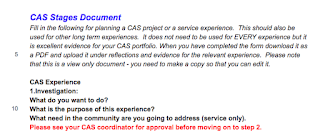 Grade 11students are off to a great start. This week I just want to remind you to check your portfolio over the break - remember a little bit every week means less work in the long run.
Grade 11students are off to a great start. This week I just want to remind you to check your portfolio over the break - remember a little bit every week means less work in the long run.That looks a bit like a rabbit rather than a hare, but I hope you get the point. ⇢
Some of the CAS experiences you have participated in:
- Teaching Swedish - to refugees and other students at the school
- Playing football - school team, local teams, with refugees
- Nepal group - web page, social media trip planning
- GEA - establishment of the Gender Equality Association
- Amnesty International group - campaign to protest the treatment of activists in Turkey - now run by grade 11 students
- Rhino group attended National Day against Rhino poaching
- Student Council - grade 11 now in charge
- On-line research - cyclone watch/Species identification in the Amazon Rainforest and Serengeti National Reserve
- Dance to Health project teaching primary students to dance and raising money for the cancer foundation
- Music groups
- Individuals playing and composing music and singing
- Sports - running, going to the gym, yoga, pilates, skating, cheer leading, water polo
- Blogs/websites/instagrams about football/food/restaurant reviews/etc.
- Arts and crafts from knitting to lino prints to sketching and photography
- Badminton lessons ending in a tournament
- Volunteer work at Red Cross, Stockholm Film Festival, Hemlösa.se (giving out food to homeless people in the mornings), Korean and Japanese schools on the weekends
- Year book pages
- Student newspaper - now run by year 11 students
- Recycling plastic bottles
- Volunteering at a cat home
- Music performances at a hospital
This list is by no means exhaustive. It is just a sample of the great experiences that our students are getting as part of the IB Diploma Programme.
Enjoy your winter break.
Still looking for new ideas. Bored during the break. Try some of these online service - research projects:
You will need:
 One symptom of Alzheimer’s that has been known since the discovery of the disease is reduced blood flow to the brain, but until now, nobody knew why. That is why this aspect of the disease, which likely contributes to cognitive problems and accelerates injury to brain cells, has remained untreated.
One symptom of Alzheimer’s that has been known since the discovery of the disease is reduced blood flow to the brain, but until now, nobody knew why. That is why this aspect of the disease, which likely contributes to cognitive problems and accelerates injury to brain cells, has remained untreated.
New specialized imaging techniques have allowed Cornell University researchers to discover a potential cause of the reduced blood flow. This suggests new treatment approaches that could slow progression of the disease to delay, or even prevent, the onset of symptoms, and possibly restore some cognitive function when symptoms are present.
However, understanding the molecular basis of the process, and homing in on the specific pharmaceutical targets using current methods could take decades, limited primarily by the need for extensive manual image analysis. Crowdsourcing this analysis to citizen scientists could reduce that time to just a few years.
Last week's blog prize was never claimed. In order to win this week's prize you need to write down all the animals that appear on this week's post and give the paper to me personally. The competition is open until the 9th January at 5 pm.
Still looking for new ideas. Bored during the break. Try some of these online service - research projects:
Satellites Over Seals (SOS)
Scientists are asking the public’s help in searching satellite images of Antarctica. This is the first-ever, comprehensive count of Weddell seals. Documenting how the seals’ population numbers change over time will help researchers better understand how climate change and commercial fishing in the Antarctic impact these iconic species.
Part of our research is monitoring the number of penguins that breed at Cape Royds every year. Knowing the numbers helps us understand what is happening to penguin populations as changes in their habit occur. Just outside the colony is a camera that takes a picture everyday of the penguins. This allows us to see the changes in numbers as the season progresses and compare year to year. We need help counting the penguins as the daily photos are not saved. If you would like to help us with this project read on!
You will need:
- Access to the internet everyday Nov to Feb.
- The Penguin Count Data Sheet
- Graph paper (optional)
Help scientists analyze brain blood flow movies - are blood vessels flowing or stalled?
 One symptom of Alzheimer’s that has been known since the discovery of the disease is reduced blood flow to the brain, but until now, nobody knew why. That is why this aspect of the disease, which likely contributes to cognitive problems and accelerates injury to brain cells, has remained untreated.
One symptom of Alzheimer’s that has been known since the discovery of the disease is reduced blood flow to the brain, but until now, nobody knew why. That is why this aspect of the disease, which likely contributes to cognitive problems and accelerates injury to brain cells, has remained untreated.New specialized imaging techniques have allowed Cornell University researchers to discover a potential cause of the reduced blood flow. This suggests new treatment approaches that could slow progression of the disease to delay, or even prevent, the onset of symptoms, and possibly restore some cognitive function when symptoms are present.
However, understanding the molecular basis of the process, and homing in on the specific pharmaceutical targets using current methods could take decades, limited primarily by the need for extensive manual image analysis. Crowdsourcing this analysis to citizen scientists could reduce that time to just a few years.
Last week's blog prize was never claimed. In order to win this week's prize you need to write down all the animals that appear on this week's post and give the paper to me personally. The competition is open until the 9th January at 5 pm.





































